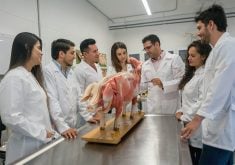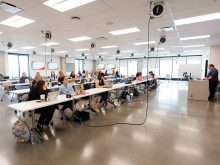When Nancy Wrayton was 14, she would arrive at the Calgary Stampede Park racetrack by 4 a.m. on cool, dark mornings to work in the stalls and ride horses. When she was finished, she caught a bus to school.
In 1985, when she was 21, she won Canada’s leading apprentice jockey award.
The mother of two from Sundre, Alta., eventually gave up the racing life but it never left her blood and she is now one of four instructors at Canada’s first jockey school run through Olds College and Stampede Park.
Read Also

Fuel rebate rule change will affect taxes and AgriStability
The federal government recently announced updates to the fuel rebates that farmers have been receiving since 2019-20.
Professional jockeys were hired to help write the curriculum and share their knowledge with young people hoping to earn a place in the sport of kings.
Alberta’s racing world faces the same labour shortage confounding skilled trades throughout the province. There are not enough jockeys, trainers or grooms and bringing in foreign horsemen is complicated.
When instructors Wrayton, Real Simard and Alex Ferris entered the jockey world, riders worked with mentors.
Trainers no longer have the time for that, yet there is a need for competent staff at the track when working with Thoroughbreds worth thousands of dollars.
There are about 1,200 horses at Stampede Park. Trainers may handle three to 40 horses and one person is needed for every four horses.
The inaugural program has turned into a dream come true for aspiring jockey Jason Wasylin.
“I wish I had found this 10 years ago because I’m old to be just getting started, but I’ve got the drive,” the 27 year old said.
Born near Edmonton, Wasylin did not start riding until two years ago. Nicknamed Waz, at five feet, five inches and 120 pounds, he believes he can make it as a professional jockey.
“I’m not afraid of hard work,” he said.
Since starting the program, he has lost seven lb. through physical labour in the barns, riding every day and cardiovascular training at a Calgary fitness centre. Outside of plenty of fruit, he eats little to control his weight and found the first few days on horseback grueling.
Students start on mechanical horses to learn how to gain control as the machine simulates movement and speed.
“My ass hurt for the first few days but once you get out on the track you are not really sitting on the horse. It is more legs and your arms and the pulling on them,” he said.
Wasylin’s biggest challenge so far is learning to relax. Jockeys are typically intense personalities and he fits the mould with moments of hyperactivity followed by extreme concentration as he saddles up and rides into the sunshine.
When he graduates this spring he hopes to work freelance at the track, galloping mounts and working with trainers until he is considered ready to be a professional rider.
This is not a life for shirkers.
The physical fitness levels and mental requirements for the students are gruelling. They need stamina, strong backs and legs and concentration so they can master the technique of controlling a 1,200 lb. horse standing 16 hands high.
Riders must be able to keep feet high in the stirrups and stand in the tiny racing saddle. This stance distributes weight better and allows riders better control as they fly around the track at 50 to 65 km-h.
The students need to ride 60 different horses before graduation in April to become certified as exercise riders. None become professional jockeys immediately. They must learn the ropes and take on the exercise riding jobs, grooming and whatever else is needed.
As they watch their students
circle the five furlong track,
Simard, Wrayton and trainer
Leanne Knechtel proclaim some of the students as naturals. Diminutive in size, these youngsters are powerful athletes who stand to make a good living if they choose to work hard.
A rider who gallops horses each day can make $9 per horse and can ride 20 to 30 horses per day. Once they hit the racing circuit, the pay cheques improve.
“It’s pretty good money. You can make a couple hundred dollars a day and we work seven days a week,” said Wrayton. Riders take two months off in the winter.
“It’s good to have the break because it is an intense sport,” she said.
The students’ classroom time started last November, where they learned about horse conformation, animal care, injuries, illnesses and ethics.
The real work started at the end of January on a windy, nippy morning as the nine students took their turns on horseback for two sessions around the track.
The instructors try to make the days as close to reality as possible, starting with early mornings.
Knechtel is in the barns by 4:15 a.m. and falls into bed by 8 p.m. Based in Airdrie, she is a former jockey and patient trainer of her new charges, who have become like her children. She also works with Olds College in the groom school and is the Horse Racing Alberta adviser for the jockey program.
Knechtel was a pioneer female jockey more than 30 years ago, but the Alberta racing fraternity is more welcoming of women today.
“I rode back when it was pretty brutal,” she said.
She keeps a close watch on the students and is quick to help. A horse comes out with the bridle incorrectly placed.
“What’s wrong with this picture?” she asks the student.
“See what I mean about always checking your tack? Good girl,” as the student corrects her error before leaving the barn.
Anxious to get on the track, the students start leaving the stalls until they get a reminder from Ferris.
“You guys don’t come out of the stalls till you are all tacked up, please.”
Eighteen-year-old Carys Richards left her home in Canmore, Alta., for the first time to enter this program. She has ridden for many years as a competitive trail rider but soon learned her new career requires a different kind of riding and knowledge.
Her instructors consider her a talented rider but for her, the greatest challenge is learning confidence.
“It’s been a lot of hard work but it’s fun,” she said.
At 5 foot 5 five inches and 129 lb., she is svelte, but too big to be a jockey. She wants to become a trainer and competent exercise rider.
“It is a lot different being on one of these Thoroughbreds with an exercise saddle for half an hour,” she said. “I thought after riding my Arab for six hour races all summer, I thought I was in pretty good shape but it works completely different muscles.”
It is a hard lifestyle but she can’t wait to start, even if work does begin at 5 a.m. as she helps Knechtel with track chores.
“There’s worse things you could get up and do at 5 a.m., like working at Tim Horton’s,” she said.
As the students move onto the track, Simard puts on his helmet and goggles, then turns off his cell phone before he jumps on his brown and white pony to ride with the students.
He started riding at 19 and was told he was too old and muscular because most jockeys started at age 16. Today, a jockey must be 18.
He watches every student, offering words of encouragement.
“You gotta go till it hurts, Kenny, and then it’s got to hurt some more,” yells Simard to Ken Ellis, who started as a groom and hopes to become a jockey.
“Some of them will never race because they are too big but they will all get into racing situations,” Simard said.
The students will become exercise riders and will take horses to the starting gate. There, animals are trained to adjust to noise, overcome the sense of being closed in and learn how to leave the gate. The horse’s natural instinct is to go forward and when it cannot, it may go backward and flip over.
Safety for the jockeys always comes first, which Simard knows from 25 years of experience and riding in 15,000 races.
“As a jockey I have had many flip over backwards. Usually the gatekeeper grabs me,” he said.
Their job is to pull the jockey out of the way and then rescue the horse.
It is important for Simard that this course continues. Above all, he wants the students well prepared because within a short time they go from being his students to his colleagues.
The students already understand the racing circuit and some of the sacrifices.
The Alberta racing season starts in Calgary in April and runs to the end of June and then moves to Northlands Park in Edmonton until the end of October. There is a B circuit for smaller tracks in the province.
Riders will work every day of the week, yet many find moving between the two tracks to be the hardest part of the life.
Some families move with the races while Simard’s family stays in Calgary and he splits his time between the two cities.
Most accept the demands and remain keen to join the winner’s circle.
“Horses are not a job, they are a lifestyle,” Wrayton said.















